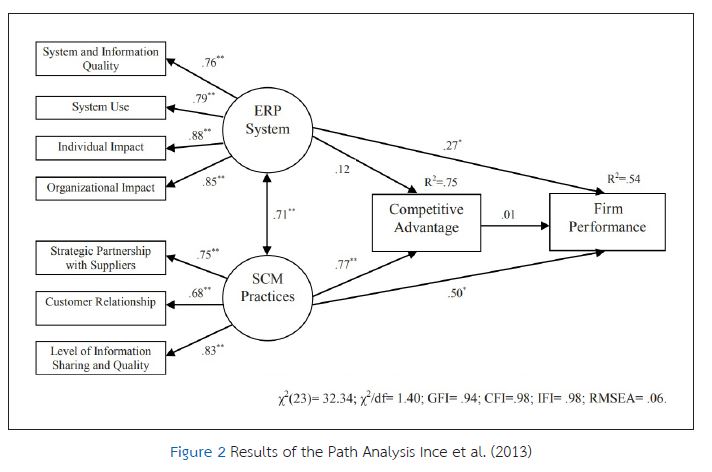อิทธิพลของระบบการวางแผนทรัพยากรองค์กรบนคลาวด์และการวางกลยุทธ์เทคโนโลยีสารสนเทศในองค์กรที่มีผลต่อประสิทธิภาพการดำเนินงานของธุรกิจผ่านกระบวนการจัดการคลังสินค้า กรณีศึกษาอุตสาหกรรมชิ้นส่วนยานยนต์ในประเทศไทย
คำสำคัญ:
ระบบอีอาร์พี คลาวด์เบส, การวางกลยุทธ์เทคโนโลยีสารสนเทศ, การจัดการคลังสินค้า, ประสิทธิภาพการดำเนินงานบทคัดย่อ
ในการศึกษาวิจัยนี้มีวัตถุประสงค์เพื่อศึกษาผลกระทบที่มีต่อประสิทธิภาพของการดำเนินงาน โดยตัวแปรอิสระ ประกอบไปด้วย การใช้ระบบ ERP Cloud Base และการวางกลยุทธ์เทคโนโลยีสารสนเทศ ในขณะที่การจัดการคลังสินค้าเป็นตัวแปรคั่นกลาง และตัวแปรตามคือประสิทธิภาพการดำเนินงาน ในส่วนของกลุ่มตัวอย่างคือผู้ที่มีส่วนเกี่ยวข้องกับระบบสารสนเทศขององค์กรเช่น ผู้บริหาร , ผู้บริหารด้านเทคโนโลยีสารสนเทศ, ผู้จัดการฝ่ายเทคโนโลยีสารสนเทศ หรือเจ้าหน้าที่ปฏิบัติการสารสนเทศ ขององค์กรในอุตสาหกรรมชิ้นส่วนยานยนต์ จำนวน 215 คน คัดเลือกโดยการสุ่มตัวอย่างแบบแบ่งชั้นตามวัตถุประสงค์จากอุตสาหกรรมชิ้นส่วนยานยนต์ มีการวิเคราะห์ข้อมูลโดยใช้แบบจำลองสมการโครงสร้าง (SEM) ซึ่งนำโครงสร้างแบบจำลองไปประยุกต์ใช้กับการทดสอบแบบจำลองสมมุติฐาน ผลลัพธ์ระบุว่าแบบจำลองมีสัดส่วนและการถดถอยของสมมติฐานทั้งหมดได้รับการยอมรับด้วยค่า p < 0.05 ส่วนผลการตรวจสอบความสอดคล้องและกลมกลืนมีความสอดคล้องกับข้อมูลเชิงประจักษ์และองค์ประกอบย่อยของโมเดลเชิงโครงสร้าง
ผลการวิจัยพบว่าการใช้ระบบ ERP Cloud Base และการวางกลยุทธ์เทคโนโลยีสารสนเทศ มีผลกระทบโดยตรงต่อประสิทธิภาพการดำเนินงาน นอกจากนี้ผลกระทบทางอ้อมยังแสดงให้เห็นในการจัดการคลังสินค้า ซึ่งระบุว่าควรนำระบบ ERP Cloud Base และการวางกลยุทธ์เทคโนโลยีสารสนเทศ มาใช้ในองค์กรร่วมด้วยการจัดการคลังสินค้าที่เหมาะสมจะช่วยเพิ่มประสิทธิภาพในการดำเนินงานขององค์กรต่อไป
References
Anđelković, A., & Radosavljević, M. (2018). Improving order-picking process through implementation of warehouse management system. Strategic Management-International Journal of Strategic Management and Decision Support Systems in Strategic Management, 23(1).https://doi.org/10.5937/StraMan1801003A
Atieh, A. M., Kaylani, H., Al-Abdallat, Y., Qaderi, A., Ghoul, L., Jaradat, L., & Hdairis, I. (2016). Performance improvement of inventory management system processes by an automated warehouse management system. Procedia CIRP, 41, 568-572. https://doi.org/10.1016/j.procir.2015.12.122
Badewi, A., Shehab, E., Zeng, J., & Mohamad, M. (2018). ERP benefits capability framework: orchestration theory perspective. Business Process Management Journal, 24(1), 266-294. https://doi.org/10.1108/BPMJ-11-2015-0162
Baruffaldi, G., Accorsi, R., & Manzini, R. (2019). Warehouse management system customization and information availability in 3pl companies: A decision-support tool. Industrial management & data systems, 119(2), 251-273. https://doi.org/10.1108/IMDS-01-2018-0033
Batini, C., & Scannapieco, M. (2016). Data and information quality. Cham, Switzerland: Springer International Publishing, 63. https://doi.org/10.1007/978-3-319-24106-7
Certo, S. C., & Certo, S. T. (2019). Modern management: Concepts and skills: Pearson.https://doi.org/10.5465/AMBPP.2019.15546abstract
Chantruprakakul, A., Lata, P., & Silpcharu, T. (2023). Factors affecting the development of Thai auto parts manufacturing industry for export. Journal of Namibian Studies: History Politics Culture, 34, 1853-1873.
Chopra, R., Sawant, L., Kodi, D., & Terkar, R. (2022). Utilization of ERP systems in manufacturing industry for productivity improvement. Materials today: proceedings, 62, 1238-1245.https://doi.org/10.1016/j.matpr.2022.04.529
Cronbach, L. J. (1951). Coefficient alpha and the internal structure of tests. psychometrika, 16(3), 297-334.https://doi.org/10.1007/BF02310555
Eampoonga, I., & Leelasantitham, A. (2023). Overall Success Factors Affecting the Performances of Hybrid Cloud ERP: A Case Study of Automobile Industries in Thailand. Journal of Mobile Multimedia, 1153-1194.https://doi.org/10.13052/jmm1550-4646.1953
Faber, N., De Koster, M., & Smidts, A. (2013). Organizing warehouse management. International Journal of Operations & Production Management, 33(9), 1230-1256. https://doi.org/10.1108/IJOPM-12-2011-0471
Faber, N., & Van de Velde, S. L. (2002). Linking warehouse complexity to warehouse planning and control structure: an exploratory study of the use of warehouse management information systems. International Journal of Physical Distribution & Logistics Management, 32(5), 381-395.https://doi.org/10.1108/09600030210434161
Fontana, M. E., & Nepomuceno, V. S. (2017). Multi-criteria approach for products classification and their storage location assignment. The international journal of advanced manufacturing technology, 88, 3205-3216. https://doi.org/10.1007/s00170-016-9040-3
Foster Jr, S. T., & Franz, C. R. (1999). User involvement during information systems development: a comparison of analyst and user perceptions of system acceptance. Journal of Engineering and Technology Management, 16(3-4), 329-348. https://doi.org/10.1016/S0923-4748(99)00014-4
Gomes, J., De Weerd-Nederhof, P. C., Pearson, A., & Fisscher, O. A. (2001). Senior management support in the new product development process. Creativity and Innovation Management, 10(4), 234-242.https://doi.org/10.1111/1467-8691.00226
Hair, J. F., Ringle, C. M., & Sarstedt, M. (2013). Partial least squares structural equation modeling: Rigorous applications, better results and higher acceptance. Long range planning, 46(1-2), 1-12.https://doi.org/10.1016/j.lrp.2013.01.001
Hair Jr, J. F., Hult, G. T. M., Ringle, C. M., Sarstedt, M., Danks, N. P., & Ray, S. (2021). Partial least squares structural equation modeling (PLS-SEM) using R: A workbook: Springer Nature.https://doi.org/10.1007/978-3-030-80519-7
He, J., & King, W. R. (2008). The role of user participation in information systems development: Implications from a meta-analysis. Journal of management information systems, 25(1), 301-331.https://doi.org/10.2753/MIS0742-1222250111
Henderson, J. C., & Venkatraman, H. (1999). Strategic alignment: Leveraging information technology for transforming organizations. IBM systems journal, 38(2.3), 472-484.https://doi.org/10.1147/SJ.1999.5387096
Ince, H., Imamoglu, S. Z., Keskin, H., Akgun, A., & Efe, M. N. (2013). The impact of ERP systems and supply chain management practices on firm performance: case of Turkish companies. Procedia-Social and Behavioral Sciences, 99, 1124-1133. https://doi.org/10.1016/j.sbspro.2013.10.586
Jeong, K. Y., & Phillips, D. T. (2001). Operational efficiency and effectiveness measurement. International Journal of Operations & Production Management, 21(11), 1404-1416.https://doi.org/10.1108/EUM0000000006223
Joshi, A., Kale, S., Chandel, S., & Pal, D. K. (2015). Likert scale: Explored and explained. British journal of applied science & technology, 7(4), 396-403.https://doi.org/10.9734/BJAST/2015/14975
Lam, C., Choy, K., & Chung, S. H. (2010). Framework to measure the performance of warehouse operations efficiency. Paper presented at the 2010 8th IEEE International Conference on Industrial Informatics. https://doi.org/10.1109/INDIN.2010.5549667
Lee, J.-N. (2006). Outsourcing alignment with business strategy and firm performance. Communications of the Association for Information Systems, 17(1), 49. https://doi.org/10.17705/1CAIS.01749
Lockett, A., Thompson, S., & Morgenstern, U. (2009). The development of the resource‐based view of the firm: A critical appraisal. International journal of management reviews, 11(1), 9-28.https://doi.org/10.1111/j.1468-2370.2008.00252.x
Madhani, P. M. (2010). Resource based view (RBV) of competitive advantage: an overview. Resource based view: concepts and practices, Pankaj Madhani, ed, 3-22.
Matende, S., & Ogao, P. (2013). Enterprise resource planning (ERP) system implementation: a case for user participation. Procedia Technology, 9, 518-526. https://doi.org/10.1016/j.protcy.2013.12.058
Mishra, A., Dutta, P., Jayasankar, S., Jain, P., & Mathiyazhagan, K. (2023). A review of reverse logistics and closed-loop supply chains in the perspective of circular economy. Benchmarking: an international journal, 30(3), 975-1020. https://doi.org/10.1108/BIJ-11-2021-0669
Muslmani, B. K., Kazakzeh, S., Ayoubi, E., & Aljawarneh, S. (2018). Reducing integration complexity of cloud-based ERP systems. Paper presented at the Proceedings of the first international conference on data science, e-learning and information systems. https://doi.org/10.1145/3279996.3280033
Nasamu, I. (2022). Strategies for employees to effect change to improve performance of public organizations: Walden University.
Sarstedt, M., Ringle, C. M., Smith, D., Reams, R., & Hair Jr, J. F. (2014). Partial least squares structural equation modeling (PLS-SEM): A useful tool for family business researchers. Journal of family business strategy, 5(1), 105-115. https://doi.org/10.1016/j.jfbs.2014.01.002
Shatat, A. S., & Shatat, A. S. (2021). Cloud-based ERP systems implementation: major challenges and critical success factors. Journal of Information & Knowledge Management, 20(03), 2150034.https://doi.org/10.1142/S0219649221500349
Srisawat, J., & Jaturat, N. (2016). The Influence of ERP Implementation and Organization IT Strategy on Supply Chain Performance through Logistic Management: a Case Study of Food Industry in Thailand. International Journal of Applied Computer Technology and Information Systems, 6(1), 61-69.
Tansakul, N., Suanmali, S., & Shirahada, K. (2021). The development of supply chain performance index by structural equation model approach: a case of Thai automotive industry. Thammasat University.
Weng, K.-F., Hung, C.-T., Hsieh, P.-T., Li, M.-L., Chen, G.-W., Kung, Y.-A., . . . Lin, J.-Y. (2014). A cytoplasmic RNA virus generates functional viral small RNAs and regulates viral IRES activity in mammalian cells. Nucleic acids research, 42(20), 12789-12805. https://doi.org/10.1093/nar/gku952
Wilson, J., Hair, C., Knight, R., Catto-Smith, A., Bell, S., Kamm, M., . . . Connell, W. (2010). High incidence of inflammatory bowel disease in Australia: a prospective population-based Australian incidence study. Inflammatory bowel diseases, 16(9), 1550-1556. https://doi.org/10.1002/ibd.21209
Yeh, J.-Y., & Lin, C.-Y. ERP Strategy and a Firm's Contextual Dimensions: A Multiple Case Study.

Downloads
เผยแพร่แล้ว
How to Cite
ฉบับ
บท
License
Copyright (c) 2024 คณะบริหารธุรกิจ สถาบันบัณฑิตพัฒนบริหารศาสตร์

This work is licensed under a Creative Commons Attribution-NonCommercial-NoDerivatives 4.0 International License.


